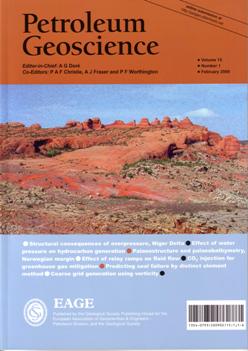
Phil Christie*, former President of the European Association of Geoscientists and Engineers (EAGE), recently became chief editor of Petroleum Geoscience. Here he offers some insights into the journal and his plans for the future.
Geoscientist 20.4 April 2010
I must have done something really awful in an earlier life, because no sooner had I handed over the EAGE Presidency to Mahmoud Abdulbaqi last June, than I found myself taking over from Tony Doré as Chief Editor of Petroleum Geoscience. I jest, of course, because it is actually a great privilege to edit the journal which I often exemplified during my Presidential overviews as representing the multi-disciplinary ethos of the association as a whole. In fact, because Petroleum Geoscience (PG) is jointly owned by the EAGE and the Geological Society of London (GSL), I am also proud to champion the cross-disciplinary values of GSL as well as being a channel for cooperation and good relations between the two societies. So now that I have been in office for just over six months, I thought I would describe the progress that has been made in PG as well as our plans for the next few years.
First, I should stress that I am by no means alone in this venture: there is an editorial team and I must pay tribute to Alastair Fraser, John Underhill and Paul Worthington for their unstinting efforts. The co-editors are supported by an international Editorial Board of 37 members, representing a huge resource of experience in academic and applied geoscience. These folks squeeze extra hours into the day to arrange reviews and to reconcile the evaluations for a recommendation to the co-editors. All this work is voluntary, with no reward save the warm feeling that a positive contribution is being made to quality literature and the profession.
PG publishes four issues a year, with the help of the Publishing House’s excellent Production Editor, Sally Oberst. The journal features papers that advance our understanding of the sub-surface, often through the type of cross-disciplinary analysis epitomised by asset teams but also often found in universities or research institutes who operate at the overlaps between traditional disciplines. Although the Editorial Board’s membership is largely European-based (even if the American and Asian-Pacific representation is growing), our content is truly global, with case studies and analyses from Asia-Pacific, the Middle East, Africa, Australasia, the Indian sub-continent and Latin America as well as North-Western Europe. Although most papers published come from individual submissions, PG dips into thematic sets from time to time and has featured return to rifts, Australasia, igneous and tectonic processes in sedimentary basins and a much-cited set on 4D seismic technology. PG welcomes papers on any topic within its broad scope, but recent developments (unconventional gas, passive seismic monitoring, geomechanics of producing reservoirs, heavy oil and carbon storage monitoring) also deserve to be aired within its covers.
PG boasts over 5000 individual subscribers, broadly spread across the globe. It is available at concessionary rates to members of GSL, EAGE and, by a special arrangement, the Petroleum Exploration Society of Great Britain (PESGB). With the advent of on-line copy, individual subscribers can access articles either in hard copy, or electronic format, or both. While this has reduced the physical print run, it has also improved global access without incurring the delay of mail. A growing number of institutional subscribers form a truly international community, represented by the UK (12%) and continental Europe (18%), North America (40%), Asia-Pacific (23%) and the rest of the world (7%).
For an applied journal such as Petroleum Geoscience, “impact factor” is probably not as relevant as it is for an academic one; but nonetheless, in the most recent year for which figures are available, PG has an impact factor of 0.808, compared to the AAPG Bulletin (1.364) and the Journal of Petroleum Geology (0.727); not too bad for a journal which is just celebrating its 15th birthday.